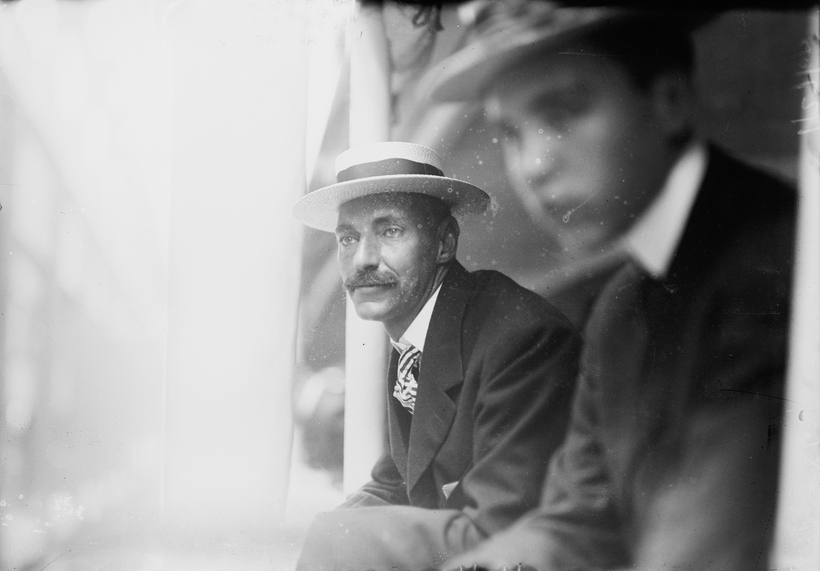The last lifeboat had gone. R.M.S. Titanic was down by the bow, poised for a final plunge. On the bridge, Captain Edward Smith grabbed a megaphone and purportedly shouted to the 2,200 passengers and crew trapped on board, “Be British!” He meant die like the heroes of old, stoical and brave to the end.
The stiff-upper-lip Smith went down with his ship, though one witness described the captain leaping from the wing of the bridge, possibly hoping to save himself. Smith’s supposed last words were carved on the plinth of a memorial erected in his honor. The exhortation—Be British!—rang out from newspapers, songs, and postcards, repeated like a catechism by countrymen determined to wring glory from the loss, on her maiden voyage, of a ship touted as “practically unsinkable.”
The Anglo-Saxon jingoism was too much for George Bernard Shaw. “The one thing positively known was that Captain Smith had lost his ship by deliberately and knowingly steaming into an ice field at the highest speed he had coal for,” wrote the era’s most famous social critic. “He paid the penalty; so did most of those for whose lives he was responsible.”
End of an Era
The Edwardian Age was over, though most Britons did not know it. World War I was two years away; with the help of their maids, upper-class women still devoted much of their waking hours to getting in and out of their clothes—a “minimum requirement of three outfit changes daily,” writes author Gareth Russell, in this lushly detailed account of the epoch-ending catastrophe at sea.

On a cold night in April 1912, the great ship, en route to New York, appeared to graze an iceberg shortly before midnight. Proper upper-crusty manners were on display as the stewards ever so politely summoned passengers to the boat deck. “I remember distinctly that there was no crowding through the doorway,” recalled one survivor. The danger was not apparent, not at first. One lady’s “first suspicion” came when she saw the pajama legs poking out from the trousers of the usually fastidious steamship company’s managing director, J. Bruce Ismay.
Captain Edward Smith grabbed a megaphone and shouted to the 1,500 passengers and crew trapped on board, “Be British!”
Men still in evening dress obeyed the ancient rule of “women and children first.” There was John Jacob Astor IV, along with Teddy Roosevelt’s friend and adviser Archie Butt, calmly walking away from the rail after bidding the ladies good-bye. Isidor Straus, the co-owner of Macy’s department store, would not step into a lifeboat ahead of other male passengers. His wife, Ida, would not leave him. She was heard to say, “We have lived together for many years. Where you go, I go.” The two perished together.
There were other moving tales of heroism, and, reports Russell, the band really did play “Nearer, My God, to Thee” as the deck slanted beneath them. Nevertheless, survival was partly a question of social standing: 62.5 percent of first class was saved, but only 41.2 percent in second class and 25.3 percent of third class. A prodigious researcher, Russell debunks the horrifying story that third-class passengers were locked below. He also notes that even if the Titanic had been equipped with enough lifeboats, there probably was not enough time to get everyone away before the ghastly finale.
A Night to Remember
“At about 2:10 a.m., those in the lifeboats heard several roars from within the hull, which sounded like the boilers exploding but which were in fact the bulkheads finally giving way,” writes Russell. Hundreds of passengers moved helplessly toward the rising stern. “It was a terrible sight. It would make the stones cry to hear those on board shrieking,” a survivor later told his mother. A second-class passenger was transfixed by “the terrible beauty of the Titanic at that moment…. To me she looked like an enormous glow worm, for she was alight from the rising water line to the stern—electric lights blazing in every cabin on all the decks and lights at her mast heads.”

The lights flickered out; the leviathan groaned and vanished. In the frigid and empty darkness, the cries of a thousand mortal souls as they beseeched the women (and not a few first-class men) floating in the lifeboats not far away. But, fearful of being swamped by panicked swimmers, they did not row back. The passengers in only a couple of boats returned to rescue those in the water. It took them nearly half an hour to row 20 yards, “so thick had the field of bodies become,” wrote Russell. One man swam to a lifeboat and asked to be helped up, but when told he might capsize them, he replied, “All right, boys, good luck and God bless you.”
Russell focuses his sprawling tale around a half-dozen first-class passengers and their families. One survivor was Jack Thayer, the 17-year-old scion of an old-money Philadelphia family, who harrowingly escaped while his father drowned. More than 30 years later, still obsessed and haunted by that terrible night, despondent over his own son’s death in World War II, he drove to a quiet place, smoked a cigar, then slashed his own wrists and throat.
Evan Thomas’s latest book, First: Sandra Day O’Connor, is out now


